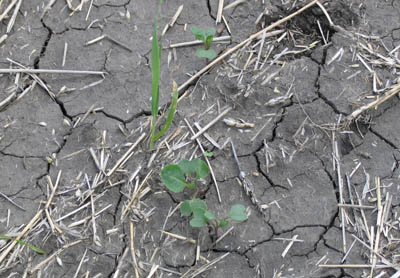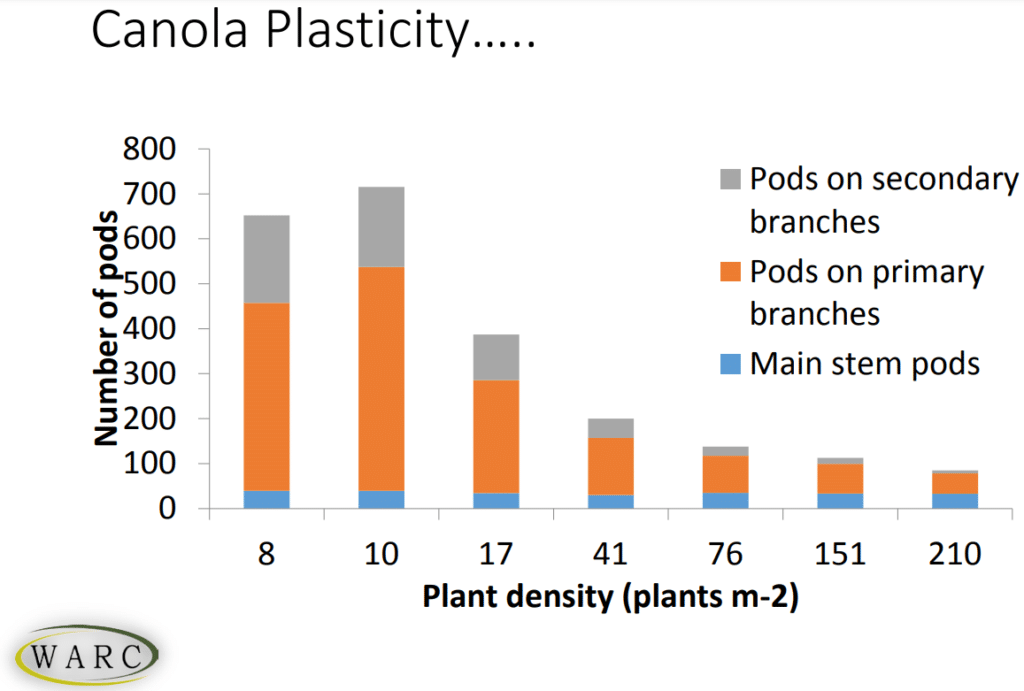
When growers have canola stands of fewer than 4 plants per square foot — due to low seeding rates, poor seed survival, insects*, crusting, frost, wind, etc. — they grapple with the question whether to reseed. An established uniform canola stand with as few as 2 plants per square foot generally has higher economic potential than a thicker stand reseeded late. This population is far below the minimum 5 per square foot generally required to meet yield potential, but a thin stand seeded early has greater economic potential (considering cost of production, yield and quality) than an adequate stand that doesn’t get established until mid to late June.
*If cutworms are the cause, they can remain a problem well into June — even for a reseeded crop. In this case, for the reseeded crop use a seed treatment that kills cutworms. Monitor for cutworm feeding when the new crop emerges, and apply an insecticide if needed.
This canola plasticity graph (below) shows how a thin stand can still produce a decent yield. Canola plants with more room to grow produce a lot more pods per plant.
However, reseeding may be the better option if:
–The stand is not uniform. If large areas of the field have fewer than one plant per square foot, while some areas have 5-10, for example, this field will not likely have the same yield potential as a field with 1-2 plants (or more) spread evenly across the field. A uniform stand is crucial at low plant populations.
–Weeds are large and outnumber the crop and cannot be controlled effectively with in-crop sprays.
–Crop insurance will pay a reseed benefit and/or seed companies have reseeding rebates on seed. This helps with the economics, especially in May when a reseeded crop still has time to reach its yield potential.
–Seed choice is another factor. A 2010-12 study at Western Applied Research Corporation (WARC) in Scott, Saskatchewan, found that re-seeding to the same full-season variety in early June resulted in significantly higher yields at 50% of sites compared to the low plant population control (fewer than 4 plants per square foot) seeded in mid May. The study found that the chances of getting No. 1 grade are lower with canola reseeded in June in this situation, but higher yield potential and a crop insurance reseed benefit can make up for it about half the time.

The WARC study also found that: (1) Re-seeding in early June to a slightly shorter season variety (the trial used 9350RR) resulted in higher yields than the earlier-seeded low population control at only 25% of site years. (2) Reseeding to Polish canola did not pay. (3) Reseeding in mid June did not pay.
Final considerations in the reseed decision, as outlined in the study, are to look at the current and forecast moisture situation to make sure the reseeded crop can emerge quickly, and keep in mind that big plants from a thin stand may provide harvest challenges in terms of variability.
Questions for grower to answer:
What are the details of your crop insurance reseeding benefit?
Does your seed company offer a reseed benefit for canola?
Further considerations:
Can growers give the crop a few more days? Waiting will give a better impression of how many seedlings survived and will give un-germinated seed a chance to emerge and contribute to the stand. If growers have crop still to seed, consider seeding those fields then come back to the reseeding question. Reseeding in late May will have nearly the same yield potential as reseeding in mid May.
Leave test strips. If growers do decide to reseed, leave at least two separate test strips from the original stand. Compare management issues for the reseeded crop and the original strips, and compare yield results. This may help with future reseeding decisions.
Fertilizer needs for the reseeded crop. If soil has low baseline P levels, some seed-placed P may benefit the reseeded crop. If soil reserves are medium or better and soils are warm and moist for rapid early growth, extra P may not be required for the reseeded crop. Sulphur and nitrogen should not be required for the reseeded crop, provided these nutrients were applied at required amounts the first time.
Spray out the first crop. If the stand is less than 1-2 plants per square foot, growers may still want to spray them out to eliminate the competition and even out maturity. These few more mature plants will not contribute to harvest yield, and the competition will take nutrients and moisture from the reseeded stand. Burnoff applied prior to the reseeded crop will also manage weed growth that may have occurred since the first burnoff. If growers are concerned about getting the reseeding done (or maybe there isn’t a good spraying day in short term), it may also make sense to seed a different HT system and spray out the previous crop in-crop. This option can also help with the issue of canola that is still not actively growing at the time of reseeding.
Reseeding is not just about yield potential. By reseeding, growers can avoid the season-long headaches that come with managing a thin stand.
Seed supply. Before you reseed, check on the seed supply. Can you get the seed you want? Refer the WARC research comment (above) on seed choice when deciding what seed to use.
Check field conditions. Reseeding into dry soil may not achieve much of an improvement in the stand and emergence will be further delayed due to slow emergence. Dry conditions may be the reason for poor establishment in the first place.
Research on this topic:
Canola plant establishment meta-analysis
Determining the optimum plant density in canola
Assessment of seed germination and seedling performance of spring canola at low temperatures